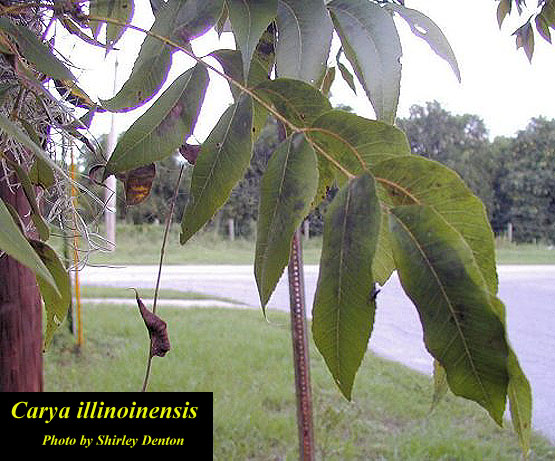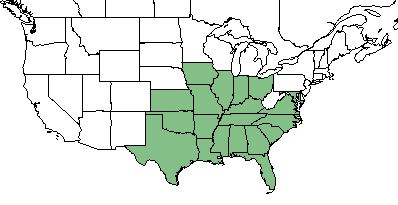Difference between revisions of "Carya illinoinensis"
(→Taxonomic Notes) |
(→Description) |
||
| Line 25: | Line 25: | ||
==Description== | ==Description== | ||
<!-- Basic life history facts such as annual/perrenial, monoecious/dioecious, root morphology, seed type, etc. --> | <!-- Basic life history facts such as annual/perrenial, monoecious/dioecious, root morphology, seed type, etc. --> | ||
| − | ''C. illinoinensis'' is a perennial tree of the ''Juglandaceae'' family native to North America. <ref name= "USDA Plant Database"> USDA Plant Database [https://plants.usda.gov/core/profile?symbol=CAIL2 https://plants.usda.gov/core/profile?symbol=CAIL2] </ref> | + | ''C. illinoinensis'' is a perennial tree of the ''Juglandaceae'' family native to North America.<ref name= "USDA Plant Database"> USDA Plant Database [https://plants.usda.gov/core/profile?symbol=CAIL2 https://plants.usda.gov/core/profile?symbol=CAIL2] </ref> Reaching heights between 100-140 feet, pecan is a medium to large deciduous tree. Leaves alternate and pinnately compound, and 11-17 leaflets that have a length between 4-8 inches. Unisexual flowers, which are located in separate clusters on the same tree. Fruit is a thin-shelled nut located in clusters of 3-12, four winged from the base to the apex, and brown in color with yellow scales. Husk is thin and can persist on branches into winter, while the nut is thin-shelled, reddish-brown, and pointed on each side. Bark can be light or grayish brown, and is shallowly furrowed and flat ridged.<ref name= "Moore">Moore, L. M. (2006). Plant Guide: Pecan Carya illinoinensis. N.R.C.S. United States Department of Agriculture. Baton Rouge, LA.</ref> |
==Distribution== | ==Distribution== | ||
Revision as of 17:51, 1 April 2019
Common name: Pecan [1]
| Carya illinoinensis | |
|---|---|

| |
| Photo by the Atlas of Florida Plants Database | |
| Scientific classification | |
| Kingdom: | Plantae |
| Division: | Magnoliophyta - Flowering plants |
| Class: | Magnoliopsida - Dicots |
| Order: | Juglandales |
| Family: | Juglandaceae |
| Genus: | Carya |
| Species: | C. illinoinensis |
| Binomial name | |
| Carya illinoinensis Wangen. | |

| |
| Natural range of Carya illinoinensis from USDA NRCS Plants Database. | |
Contents
Taxonomic Notes
Synonyms: Carya illinoensis; Hicoria pecan (Marshall) Britton; Hicoria texana LeConte
Varieties: none
Description
C. illinoinensis is a perennial tree of the Juglandaceae family native to North America.[1] Reaching heights between 100-140 feet, pecan is a medium to large deciduous tree. Leaves alternate and pinnately compound, and 11-17 leaflets that have a length between 4-8 inches. Unisexual flowers, which are located in separate clusters on the same tree. Fruit is a thin-shelled nut located in clusters of 3-12, four winged from the base to the apex, and brown in color with yellow scales. Husk is thin and can persist on branches into winter, while the nut is thin-shelled, reddish-brown, and pointed on each side. Bark can be light or grayish brown, and is shallowly furrowed and flat ridged.[2]
Distribution
C. illinoinensis can be found in the southeastern corner of the United States. [1] It was originally native to the south-central U.S., but is now more widespread into the southeastern region due to cultivation. [3]
Ecology
Habitat
C. illinoinensis is found in bottomlands, suburban woodlands, rural forest edges and floodplains, and is commonly cultivated around dwellings and in orchards. [3] [4]
Fire ecology
C. illinoinensis is not fire resistant, and has a low fire tolerance. [1]
Use by animals
C. illinoinensis is not highly palatable to grazing or browsing animals, but is highly palatable to humans. [1]
Conservation and Management
Cultivation and restoration
C. illinoinensis is a highly cultivated plant due to its use by humans as food. [3]
Photo Gallery
References and notes
- ↑ 1.0 1.1 1.2 1.3 1.4 USDA Plant Database https://plants.usda.gov/core/profile?symbol=CAIL2
- ↑ Moore, L. M. (2006). Plant Guide: Pecan Carya illinoinensis. N.R.C.S. United States Department of Agriculture. Baton Rouge, LA.
- ↑ 3.0 3.1 3.2 Weakley, A. S. (2015). Flora of the Southern and Mid-Atlantic States. Chapel Hill, NC, University of North Carolina Herbarium.
- ↑ URL: http://herbarium.bio.fsu.edu. Last accessed: June 2018. Collectors: Loran C. Anderson, R.K. Godfrey. States and counties: Franklin County Florida, Leon County Florida, Gadsden County Florida, Jefferson County Florida, Jackson County Florida, Liberty County Florida, Washington County Florida, Holmes County Florida, Madison County Florida.